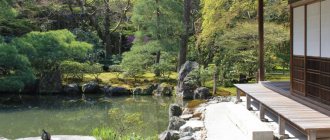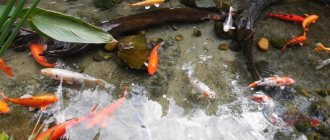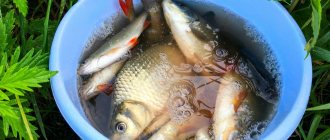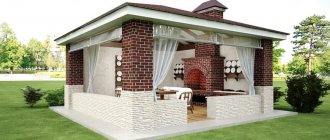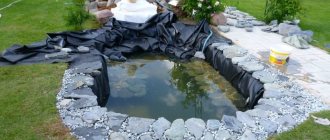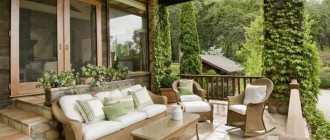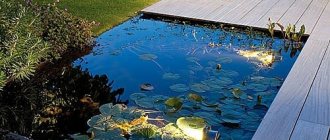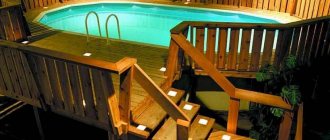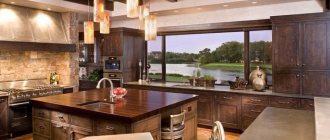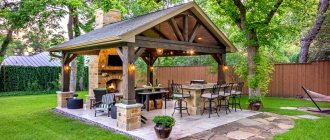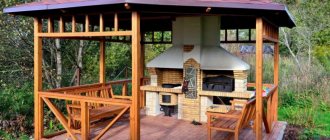Which business idea should you choose? Let's try to find the answer to this question. Many of us don’t think about how food gets to our dinner table. We are not interested in where or how they were grown or produced, the main thing is the end result. We want to always consume fresh and high-quality products. Live fish has always been and will be in great demand among the population.
It's no secret that many men like to sit with a fishing rod by the pond, relax, fish, and making this hobby their business is a dream for many, which can come true if you set a certain goal.
Moisture-resistant coating
If you do not strengthen the walls of the pond, then over time the water will erode the ground. To avoid landslides and water leakage, the inner surface of the pond is covered with plastic film, which does not allow water to pass through. For a pond 2 m deep, 3.5 m wide and 8 m long, you will need about 50 m 2 of plastic film.
Three sections of a double sleeve of film 15 m long and 3 m wide need to be soldered to obtain the required size of the moisture-resistant coating. Soldering is carried out using a soldering iron for polypropylene pipes, heated to a temperature of 260 ° C, and the rules. Place a strip of paper under the hot soldering iron. After soldering, you should get two even seams 1 cm wide.
Place film, soldered in a double layer, into the pit. Over time, the top layer of coating will deteriorate. A two-layer coating will last longer.
A fence can be made around the perimeter to prevent animals from falling into the pit before it is filled with water. In addition, the fence will serve as protection against thieves, and its supports are perfect for installing lighting.
Business plan for breeding carp in your own pond
The money spent on breeding carp in your own pond will pay off pretty soon, this is because carp grow very quickly, with proper nutrition and supplementary feeding. And he is also not whimsical. Carps reach weight in a short period of time and by the age of two years they already weigh 2 kilograms. And after more time, he grows at an incredible speed and by the age of 20 his weight exceeds 20-25 kilograms. Carps have good and tasty meat, and with a high quality index. In the 3rd or 4th year of existence, the carp reaches sexual maturity. The carp spawn is prolific and produces about 1.5 million eggs. Carp is hardy and can withstand being in water, even in those where there is little oxygen. With minimal costs for carp breeding, in the first season you can already make a profit of 200-300%. Such yield depends on your capabilities and desires. First of all, the acquisition of healthy fry, as well as the construction of a reservoir (pool). Before releasing the fry into the pond, the fry can first be raised in an aquarium. business also be done legally and at the official level. You can measure the weight of a carp using scales, and if they are comfortable, then the process of measuring the weight of a carp will be easy. Libra is here. PRESS.
Lighting installation and safety
Metal poles 2.5 m high are installed along the entire perimeter of the pond at a distance of 2.5 m - 3 m from each other. Then they are covered with chain-link mesh. Inside the fence it is necessary to install an electrical panel with a socket for the aerator and a switch.
Two LED lamps are installed on one of the posts. One of them should be directed towards the pond, and the second - in the opposite direction. You can install a light sensor on the lamps so that they turn on automatically in the evening or in cloudy weather.
The aerator and lamps will receive power from a common electrical network with the residential building. To avoid electric shock, a separate high-sensitivity RCD is installed in the house. If the wire breaks, the pump or aerator breaks, the protective device will stop the supply of electricity.
How to create the desired microclimate in a pond?
Fish in the pond should not swim until the necessary microclimate has been created. This means that launching them into the pond immediately after the water has been poured is the wrong move. The liquid should warm up well and settle for microflora to form. To avoid waiting too long, you can speed up this process. It is enough to add 5-7 buckets of water from a natural reservoir to the country pond, and cover the bottom with withered grass.
A neutral environment is the best option. As for the acidity level, it should be 7-8 pH. Measure the acidity level in a timely manner and ensure that it does not fall or rise. For example, if acidity drops to pH 5, it can negatively affect the life of carp, crucian carp and some other fish.
How to increase the acidity of water? Very simple. Chemistry for a fish pond comes down to adding limestone or soda. Measure the acidity level in 2-3 places to be on the safe side.
And one more important rule. Make sure that the temperature of the reservoir and the water in which the fish were previously kept is approximately the same. If this is not done, the fish in the pond will experience temperature shock and quickly die.
Arrangement and filling of the pond
In order to breed fish, you need to create all the conditions for its comfortable life:
- cover the plastic covering at the bottom of the pond with clay and sand;
- make a wintering pit for fish;
- install artificial burrows and places for laying;
- lay logs and stones on the bottom, plant algae in the pond, that is, create conditions close to natural.
The logs need to be weighed down with weights so that they do not float when the pond is filled with water. The place for luggage is a wooden canopy with several artificial holes made of plastic pipes or bottles.
The canopy can be raised above the surface of the water and a ladder attached to it. Then you can swim in the pond.
At this stage, you can fill the pond two-thirds with water and add a few fish there. As a rule, 20% of the maximum number of individuals is first populated. A pond designed for 250 fish can accommodate 50 small fish. It is desirable that these be three different types.
Commercial fish
If you are going to set up a pond for fishing, then the following fish species are most in demand for this purpose:
- Carps are the most popular species due to their unpretentious living and feeding conditions. Carps love warmth and sun. In a small pond they quickly gain weight. Puberty occurs at the 4th year of life. A wide variety of species allows you to choose the fish you like.
Carp - Tench feed in shallow water. Like carp, it is omnivorous. Reacts calmly to changes in water acidity and oxygen levels in it. Adaptable, adapts to life in any pond. Does not get along well with crucian carp and crucian carp, as these species are competitors in food.
- Crucian carp prefers stagnant water with an abundance of vegetation. In winter, the reservoir must have an ice hole for oxygen supply.
Advice. Purchased fish must be properly released into the reservoir. The water temperature of the pond and the tank in which the fish was brought should be approximately the same. Shock due to temperature differences will lead to the death of the fish.
Strengthening the pond bank and planting algae
To plant plants in a pond, use a pot filled with clay and sand. Such pots are lowered to a depth of 20-50 cm and secured with wire.
When securing the pots, do not pierce the polyethylene coating. For fastening, a nylon mesh is used, under which stainless steel wire is threaded.
Higher algae and marsh plants are planted in an artificial pond, such as:
- golden algae;
- cryptophytes;
- marsh calamus.
After the plants are planted, the shore of the pond is strengthened with oak stumps. They are nailed to a nylon mesh. This will further protect the pond from landslides and also provide protection from overflow. For aesthetics, the bank can be leveled by pouring sand and clay level with the stumps.
Sales of products
Even before the first batch of products is ready for sale, effective marketing methods should be carefully considered.
Sturgeon fish is valued by consumers, so it can be distributed in different ways:
To attract as many customers as possible, you need to invest in advertising. You can learn about products from the media and the Internet.
You can sell fish not only in raw form: smoked carcasses are also popular, but in this case you need to have your own smoking workshop. As the scale of the business develops, this industry can also be developed.
In addition to carcasses, you can also sell sturgeon liver: it is a delicacy product, so restaurants and cafes will readily purchase it.
It is most profitable to sell black sturgeon caviar, since its price can reach up to 100,000 rubles.
Sturgeon is listed in the Red Book, so catching it in water bodies is prohibited by law. Thus, black caviar is a scarce delicacy product. Its sale, like the sale of fish, can only be carried out by representatives of home farms who have all the documentation necessary to carry out their activities.
Breeding sturgeon on a home farm is a profitable business sector that will allow you to receive your first income within 9 months. It is necessary to take a responsible approach to organizing the industrial process and provide favorable conditions for the existence and reproduction of this noble fish.
Source
Pond on a fish breeding site
Perhaps every owner of a summer house or country house dreams of having a personal pond for fish farming on his property. A small pond on the site can be a place of rest, a source of water for irrigation, and a supplier of fresh fish to your table.
Artificial fish pond
Constructing an artificial reservoir for fish of small but sufficient size and depth is a technically simple task, but it will also require a lot of effort. You should also be aware that a personal pond and its inhabitants will require constant care from the owner. Many users of forumhouse.ru have already acquired their own ponds and are happy to exchange experiences on their creation, arrangement and fish breeding. If you are planning to make a pond with your own hands and start fish farming in a summer cottage format, use their advice.
Before building a pond, you need to decide on its location and size. The optimal size for breeding a small amount of fish is 30-50 square meters. A large pond requires significant investment, while a small one requires constant maintenance. But keep in mind that in a pond of two to three hundred square meters in area, growing fish for years, leaving them for the winter, will be too troublesome and expensive, such a fish will turn out “golden”. The best option is to buy fish seeding material, grow it over the summer, and catch it in the fall for the table. The optimal depth of a small pond is about two meters; you can swim in such a pond, and the fish will be comfortable. You can also raise fish in a so-called cage - a part of the pond fenced off with a mesh wall.
The fish pond on the site should be placed in an open place, which will be well lit by the sun in the morning, and by the middle of the day it should remain entirely or half in the shade so that the water temperature does not rise too much: in warm water algae multiply faster, and the fish may lack oxygen. There is a rule: direct rays of the sun should not illuminate the pond for more than ten hours, optimally - no more than six.
It is better to build a pond that will be elongated in length than to have a round or square shape: it is more convenient to swim in such a pond, plant plants along the banks and take water from it for irrigation.
To fill reservoirs, various sources are used - streams, high-lying groundwater, wells. And it is worth conducting preliminary tests to determine the suitability of the water for fish farming. Such analyzes are carried out in sanitary and epidemiological services or fisheries laboratories.
You also need to examine the soil at the construction site of the future pond: how well it will maintain the water level. Soil with a high content (above 30%) of clay and loam is suitable for fish farming, but for sand you will have to create artificial waterproofing, which means serious additional costs, especially if we are not talking about a film, but about capital, concrete waterproofing.
The bottom topography of the reservoir in which fish farming is proposed should be complex - with alternating shallow and deep-water areas.
After the bowl of your reservoir is filled with water, it should be allowed to settle for at least ten days, and only then begin landscaping and planting. It is best to do this in early summer. Underwater and above-water plants in the pond will not only perform a decorative function, but also maintain the natural biological balance in it and serve as a kind of filter for the water, especially if concrete was used for waterproofing.
Calculating the number of fish
We calculate how many fish can be kept in a small garden pond. One fish 10-15 centimeters long requires a minimum of 50 liters of water. The calculation is not difficult to make, but it is important to consider that the fish grows quite quickly. In an overpopulated pond, its inhabitants will lack oxygen and food, and the water in it will deteriorate faster, especially if there is insufficient or no filtration.
What types of fish to breed
The answer to this question depends on the geography of your region, climatic conditions, water temperature in the reservoir and many other factors. The most popular representatives of the aquatic world near Moscow for cultivation include carp, crucian carp, tench, grass carp, and silver carp. Many people successfully grow predators such as perch and pike, as well as crayfish, in their ponds. A frequent inhabitant of country water bodies is koi. They try to breed this fish not for benefit, but for aesthetics: it has a somewhat unusual, very beautiful color, and is always interesting and pleasant to look at. However, like its relative, the carp, in search of food, koi actively digs in the bottom of the reservoir, creating turbidity, so if there are a large number of individuals, you can forget about the transparency of the water in your pond.
Fish that live in a large reservoir with a large number of plants and microorganisms most often do not need additional feeding; they already have enough food. But when farming fish using a small pond, if you want to get well-fed products as a result, you will have to feed the fish. But even here you need to strictly observe the measure: excess feed mixture that is not eaten by the fish quickly turns sour and spoils the water in the reservoir.
How to grow fish at home
There are 3 ways to grow fish at home.
Extensive method
The most cost-effective method, since there is no need to purchase feed: the fish feed on the food supply of the pond.
This method is used in warm regions and in large reservoirs in which the food supply allows for breeding several species of fish.
Intensive method
The fish are fed artificial feed and fertilizers. The intensive fish farming system is divided into several technologies that are used in large enterprises: traditional, continuous, high-intensity and the method of growing commercial fingerlings.
Semi-intensive method
Using this method, fish farmers feed fish with both natural food and special artificial feed mixtures.
This method of cultivation allows for economical use of natural food resources and accelerates the growth of fish.
Types of Fishing and Bathing Ponds
Before you start building a reservoir on your site, you should familiarize yourself with the types of such structures. They are distinguished by the complexity of arrangement:
- Single-volume.
- Two-volume.
Each type includes several different variations. Single-volume can be represented by reservoirs:
- without clear zoning and technical devices;
- with surface flow;
- with the presence of a flow-through recovery zone.
The first variety will fit well into the landscape of a large plot. To purify the water in such a pond, biological organisms (plants, zooplankton, etc.) perform the purification process. The majority of this design will be occupied by sections with natural filters. The reservoir pool is not divided into zones and does not involve the use of complex technological devices. Its advantage is maximum naturalness.
A pond with a surface flow is also a single area, not divided into zones by partitions. This model uses a skimmer to filter water, and a pump to pump it. The design is convenient in that the swimming area will be much larger than in the first option, where microorganisms act as a filter.
The two-volume design provides a clear separation of the swimming area and the area with filters. Its design uses automated systems for pumping and purifying water. Temperature control devices and biofilters are also available. Such a pond will be the most comfortable for active pastime, but at the same time it requires significant financial costs.
Ponds are also distinguished by the type of water supply:
- key - filled from a natural spring located one level above the dug pit;
- stream - assumes the presence of a stream on the site, which is blocked by a dam, which allows you to create a warm reservoir;
- dug - created in an area where there are no natural sources, and filling with liquid occurs due to groundwater.
DIY fish pond without film
The simplest fish pond that you can build with your own hands is a structure with a dirt bottom and walls. The pit must be carefully compacted, but still this structure is considered not strong enough and comfortable for fish, so it is better to use film as the main covering.
Figure 6. Bottom drains: a - regular (1 - grate, 2 - riser, 3 - flaps, 4 - dam, 5 - deck chair), b - simplified (1 - head, 2 - deck chair, 3 - valve gate, 4 - winch, 5 - fish catcher), c - drainage without riser (1 - hole, 2 - shield, 3 - rod for lifting the shield, 4 - grooves for the movement of the shield, 5 - concrete head, 6 - dam slope)
In fact, the technology for constructing a pond for breeding fish from film and without it is practically no different at the initial stage. Differences appear only at the end, when the bottom and walls of the pit are covered with polyethylene.
Peculiarities
The most important feature of creating and arranging a pond is the correct choice of location. It is desirable that the soil be clayey, since such soil retains water well (Figure 8).
Figure 7. Types of fish traps
In addition, it is better to build a reservoir on the southwest side so that the water is warmed by the sun for at least 4 hours a day. It is not advisable to locate the pond under the shade of deciduous trees, as falling leaves will pollute the pond.
It is important to correctly calculate the depth of the reservoir. The optimal depth is one and a half meters, but it is better to increase this figure to two meters, and if you are going to grow carp, then to 2.5 meters. This feature must be fulfilled so that the fish can be in the pond not only in summer, but also in winter.
Construction technology
To make a pond on a fish breeding site, you need to follow a clear sequence of actions.
Step-by-step instructions for building a pond include the following steps:
- Mark the territory of the future reservoir by scattering sand over its intended territory. Uneven terrain must be leveled so that the water in the pond is approximately at the same level.
- Dig a pit, and its depth should be slightly greater than planned. This is necessary so that in the future you can arrange the bottom of the reservoir. All large boulders and plant roots are removed from the bottom, and the coastal, shallow and deep zones are marked for further development.
- We create artificial differences in water level using soil from the bottom of the pit. It is at this stage that the amount of film required is calculated. Cords are placed along the perimeter of the pond, their total length is calculated and 50 cm are added on each side. If you are not planning to make a pond out of film, you can skip this step.
- We equip and strengthen the bank by filling it with crushed stone or strengthening it with pipes and boards. This will prevent the banks from collapsing in the future. It is also advisable to make a small fence to prevent rainwater from washing the soil into the pond and polluting it.
Figure 8. Stages of constructing a pond without a film.
At the final stage, landscaping of the pond is carried out. A special substrate is placed at its bottom, in which aquatic plants are planted. You can also decorate the bottom with stones or broken pots if you plan to grow not only fish, but also crayfish. After this, you can begin installing the pump, filling the pond with water and stocking the fish.
Layout and sketch of the future pond
Before starting work, you should display your idea on paper. The diagram should show the following:
- view of the pond from above and in section;
- design parameters - usually the area of such a pond starts from 20 m², and the depth - from 2 m;
- bottom landscape;
- location of pipes or sources of water supply;
- filter localization;
- beach area;
- decorative elements.
The easiest way to solve this problem is with the help of a planning specialist. This will be especially true for those who do not have experience in such matters, since paying for a designer’s services will be much cheaper than correcting mistakes.
What do they feed carp?
Baiting of carp is carried out in one place and at one time. Feeding is done 2 times a day (morning and evening). The carp will definitely be gathering in the feeding area by this time. And further catching of large carp will be easier if you don’t do this. Carp feeds on any of the proposed plant foods (compound feed or worms). In order for the carp to produce environmentally friendly meat, it is necessary to abandon the use of chemical additives and its diet. In terms of vitality, carp, in comparison with other types of fish, is not whimsical and not demanding. Reproduction in carp is in the lead among freshwater animals, compared to aquaculture.
Choosing a location for a pond
When creating a pond with your own hands, you should choose the place where it will be located. In this matter, you should focus on what kind of inhabitants will live in the reservoir. Lowlands or flooded areas are best suited for such purposes. When breeding crayfish, at least 50% of the reservoir must be shaded.
The main condition is good diffused lighting. But one part of the reservoir must be in the shade, since the fish look for cooler places in the heat. Otherwise, the risk of death of living creatures increases.
When choosing a location, you should also take into account the need to install certain equipment, so you need to locate the pond as close as possible to electrical sources. It is also worth considering the terrain of the site. Uneven areas can be used to create a multi-level pond, and flat areas will allow you to create a pond of any shape. In addition, the type of soil is important. If these are sandstones and sandstones, you will have to additionally think about strengthening the banks.
For areas where underground flows pass at a depth of 5 m, it will be advantageous to locate a pond with a depth of up to 3 m. In this case, you will not have to worry about additional strengthening of walls and banks, unless, of course, the site has sandy soil.
Preparing for winter and liming the pond
The pond needs to be prepared for winter. In order to provide access to oxygen for the fish, reeds are placed in the water. This plant will prevent the water from freezing, and a natural hole will form.
In winter, the fish hibernate and do not move. Because of this, it is susceptible to attack by pests. To prevent diseases, the pond is limed in the fall. 6 kg of lime are added to 50 m 3 of water.
A pond with fish in a garden or summer cottage has long ceased to be a curiosity. Instructions for its creation and the necessary materials are now quite accessible. This detail is good not only for its ability to grow fish, but also for its aesthetic properties that are pleasing to the eye.
Do you have free space on the site, desire and time? Then you can get down to business, taking into account the recommendations and step-by-step techniques.
Pond at the dacha for raising fish with your own hands
Contents of step-by-step instructions:
Construction of a pond
Creating an artificial pond begins with preparing and marking the site. First of all, the area should be cleared of debris. Then stakes are installed around the perimeter of the proposed recess and strong threads are pulled through them, 20 cm of soil are removed. The top fertile layer of soil should not be wasted. You can use it on your farm or sell it.
Pond pit
Digging a pit should be approached with the utmost seriousness. The strength and appearance of the structure will depend on the quality of work performed at the initial stage. Manipulations can be carried out not only with a shovel, but also with special equipment if it is a voluminous structure. You need to start digging from the central part, the area allocated for the water body.
Having made a hole of the required depth, they begin to move to the sides. At the same time, when digging a pit, it is necessary to maintain a reserve of at least 10 cm, for example, if a depth of 2 m is required, then you need to make it 2.1 m. This place will be occupied by drainage. The banks are made at an angle of 45° so that they do not collapse.
Video: How to dig a pond
Laying waterproofing material
PVC film can be used as waterproofing. To secure it, you will need to make a ditch measuring 30x30 cm, retreating 30–55 cm from the edge of the dug hole.
Step-by-step instructions for laying film:
- Line the prepared pit with material. Allow allowances of approximately 40 cm on the sides.
- On the bottom, already covered with film, distribute 50 cm of sand, then 80 cm of pebbles or crushed stone.
After completing the above work, you can begin filling the pit with water. If the soil on the site includes a large amount of sand, you will have to approach waterproofing differently. In such cases, it is better to use a rigid form, that is, buy a ready-made plastic container or fill the bottom with concrete, and then make brickwork. The second option is more expensive and energy-intensive, but will last longer.
Pump installation
At the last stage, pumps for water distillation are installed. They come in two types:
- submersible - placed directly on the bottom of the pond;
- centrifugal - located next to the reservoir, but below the water column.
The equipment is connected to the source and the filtering device. This way the water will be purified and then returned back to the pool.
Carp breeding time
In winter, carp have a kind of protection from mucus; during severe frosts, the water can freeze, which can be detrimental to the carp, but just for these cases it burrows into the muddy bottom of the reservoir and is abundantly covered with that same protective mucus in order to accept that same sleeping regime during wintering. In their pond for the winter, the owners install pumps to enrich it with oxygen; as you know, oxygen is needed not only by humans, but also by fish. Fish can easily die from oxygen starvation. In some frosty regions of the country, fishermen specially make holes in rivers during periods of frost so that the fish do not disappear altogether, in this way the fishermen save the living creatures living in the reservoir, otherwise there will be nothing to catch later. So, during the winter period of the carp’s existence, it is necessary to make holes in the reservoir. For reference: carp usually makes so-called sighs with their gills 40 or 45 times, and in winter 3 or 4 times, and since it is in hibernation mode, it is not interested in food. With the beginning of winter, carp's digestion slows down and stops completely during the wintering period.
Fish breeding rules
Breeding fish in a pond at the dacha also has its own nuances. The first step is to make sure there is oxygen in the water. Otherwise, the reproduction of living creatures will occur very slowly, and the risk of extinction of some representatives will also increase. The function of supplying liquid with air in such reservoirs is performed by vegetation.
Purchase floral decorations for the pond in specialized stores. Vegetation is selected according to the depth of the pond. Susak, chastuha, and barnacle are suitable for shallow waters, and basilisk, Siberian guillemot, and loosestrife are suitable for deep pools.
Plants are planted in the spring, at the end of May. They should be placed in separate containers. This approach will allow you to create an area with floral decoration and not take away the space reserved for swimming. You can buy ready-made soil mixture for aquatic plants or mix clay and peat yourself in a 2:1 ratio. First, the bottom of the container is lined with burlap. Plants are placed at a depth of no more than 2/3 of the container.
When it is noticeable that the floral elements have taken root, you should check the acidity level. To do this, use special devices or litmus papers. The indicator should be neutral. Otherwise, the fish may not take root in the pond.
Otherwise, the rules for breeding fish will differ depending on their species. It is recommended that you first study all the necessary information on specific representatives of the water kingdom.
Seasonality of business. Payback
Pond fish farming is a seasonal business. The ponds are filled with planting material only in the spring. To prevent the fish from suffocating in the pond in winter, holes are made on the surface of the ice. Before the autumn-winter period, it is necessary to calculate the amount of fish in the reservoir per 1 cubic meter. water. This is necessary so that she can successfully overwinter and have enough oxygen. Fish for sale are caught mainly in the fall. In summer, she grows quickly and gains weight.
The country's population does not experience a shortage of live fish during the 3 autumn months, when it is actively caught from ponds. The rest of the time, products from cages, basin farms and closed-cycle water supply plants are sold. The price for such fish is much higher than for those that were raised in ponds.
The seasonality and irregularity of this type of business prevents fish farms from actively developing. They can receive real money only for 3-4 months, and the rest of the time they have to invest in production development.
It will be possible to receive a good income only if you have a well-written business plan.
For example, let’s take a farm that plans to breed carp. Expenditure part of the business plan:
- purchase of fry - 10,000-11,000 rubles;
- workers' wages – 30,000 rubles;
- purchase of fish food – 7,000 rubles;
- other costs - 20,000 rubles.
- Total – 68,000 rubles.
The gross profit of such a business can be about 100,000 rubles. If you take into account all expenses, income without paying tax will be 32,000 rubles.
The competition in this business is very high. But if you feel the strength and desire to work, success will not take long to arrive.
A pond in a summer cottage can be used not only for decorative purposes, but also for fish breeding. A small artificial reservoir 2 m deep can contain more than 200 individuals of carp or crucian carp. You can also add crayfish to the pond.
Pond care
The pond area will require some maintenance work. This will not be difficult if the pumps and filtration devices are connected correctly. The only thing you need to do is to periodically clean the equipment from dirt.
You can build a decorative swimming pond, which is also suitable for fish farming, with your own hands. It must be organized in accordance with all rules and technologies, taking into account the location of communications that will need to be connected to ensure proper operation of the reservoir.
Sources:
https://glav-dacha.ru/prud-dlya-razvedeniya-ryby/ https://www.forumhouse.ru/journal/articles/5726-prud-na-uchastke-dlya-razvedeniya-ryby https://fermer .blog/bok/blagoustroystvo/iskusstvennye-vodoemy/prudy/vidy-prudov/16483-prud-dlya-razvedeniya-ryby.html
Feeding fish
To successfully breed fish, you need a responsible approach to feeding it. As mentioned above, the most problem-free carp in this regard is the carp, which absorbs almost everything that is given to it. In particular, he will be happy with feed for poultry or pigs.
Before feeding, the feed in powder form must be mixed with water until a mushy consistency is obtained, after which it can be sent to the pond. The price of such complementary foods is quite affordable.
In the photo - feeding fish
Other breeds can be fed a mixture of legumes and cereal grains. Before feeding, the mixture must be steamed until it swells. The volume of feed should be 3-6 percent of the weight of the fish.
Advice! It is convenient to carry out complementary feeding on a special tray table, which can be easily taken out of the water and then lowered to the bottom again. This device allows you to monitor whether all the food has been eaten and whether there are any pieces left that pollute the water.
That's all the feeding nuances you need to know for successful fish farming in the country.
